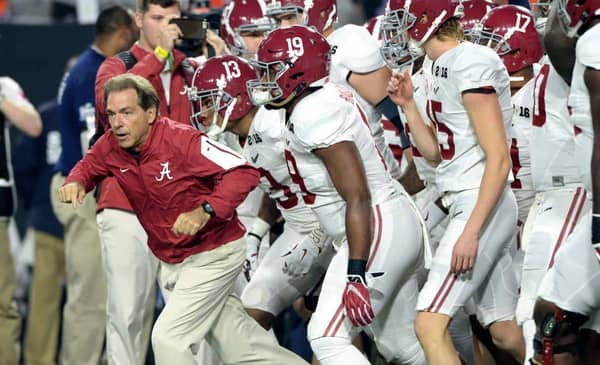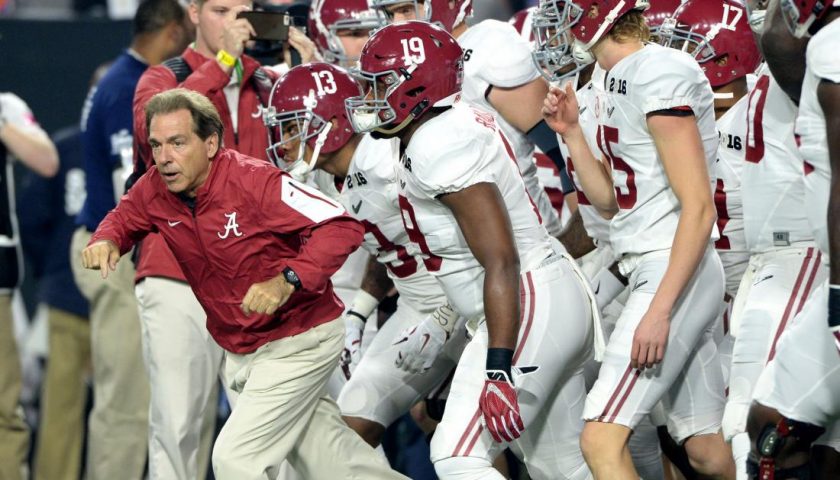

The University of Alabama Football Program
One of the biggest debate that continues to come up in our society is whether or not collegiate athletes should be paid for their time at Universities.
As a pre-cursor, note that this article will focus primarily on collegiate football players.
There is no denying the amount of money that the NCAA makes. In fact, according to an audit completed by USA Today Sports and reported by the Huffington Post, the NCAA brought in $989 million in revenue in 2014 and after expenses finished the year with a surplus of $80.5 million. Most of this money comes from television deals. Not too shabby for a non-profit organization.
This is where the argument stems that the athletes should be paid for the empire that was built on their backs.
Wrong.
An empire that they are invited to join that gives them a free avenue to pursue their dreams of being a professional athlete. Or a free avenue to get a prestigious engineering degree while playing a sport that they love.
Let me be very clear, in no way should athletes be paid while in school, BY THE UNIVERSITY. I will explain the latter part later on.
The concept of going to college for free is priceless, but let’s go ahead and put a price tag on it.
In the NCAA Division I there are 352 schools. The average single Men’s scholarship is valued at $14,270, while the average Women’s scholarship is valued at $15,162, according to scholarshipstats.com.
Undoubtedly the programs that bring in the most revenue for schools are Men’s Basketball and Football. There are 351 men’s basketball teams in Division I. The average men’s basketball scholarship per year is $38,246 with the low scholarship coming in at $28,896 and the high scholarship awarded at $53,075. The average amount of scholarships awarded per team was 13 in 2016, indicating that the entirety or at least vast majority of the team was playing on scholarship.
For collegiate football, there are currently 129 FBS teams in the NCAA. The average football scholarship per year was $36,070 with the low scholarship coming in at $25,237 and the high scholarship awarded at $42,443. The average number of players awarded some kind of scholarship were 88 players.
The total value of collegiate athletic scholarships and other financial aid awarded to Division I athletes is valued at $4.4 Billion, with athletic scholarships awarding $2.2 Billion alone.
If these numbers transcribed to hard cash values then one would find these payouts as fairly good salaries for an 18-year-old kid with nothing more than a high school education.
Unfortunately, a lot of people bypass these figures that are given to so many athletes and merely come to the conclusion that athletes play for free while earning huge dollars for the University and NCAA.
Now while I would not argue that the latter isn’t true, I pose this questions…Why should college athletes be placed on a pedestal above other students all across America?
Think of it this way.
College sports are essentially an internship.
The definition of an internship is the position of a student or trainee who works within an organization, sometimes without pay, in order to gain work experience or satisfy requirements for a qualification…in this case the NFL or NBA.
I have heard some people compare college athletics to indentured servitude, which is defined as a person under contract to work for another person for a definite period of time, usually without pay but in exchange for free passage to a new country.
In my opinion, this is a harsh comparison because of its historical context, but by definition, they have very similar meanings in context, and in the reality of our society, is somewhat of a right of passage for all young adults before they move on to full independence.
College is an incredible forum to enhance your talents, better your craft, and utilize the market to entice future employers. The major difference is that while athletes at top schools get to use this forum for free, the majority of students pay a hefty price to use this same platform.
Just ask every student that works a free internship while also piling up thousands of dollars in student loan debt, i.e. myself.
Now while most interns probably do not earn the same type of money for their organization that football players earn the NCAA, it is still the same concept of working for free to better your skills for the future.
I myself have worked multiple internships where I earned my employers thousands of dollars and yet did not receive a dime for myself.
The one major difference and one that I do disagree with is that I was able to earn money in other ways, whether it be another job or other formats, while student-athletes are not allotted this allocation.
However, the argument that student-athletes make all this money for their Universities and yet they cannot afford to eat is a complete farce, or at least in current times.
In April of 2014, the Division I Board of Directors voted to allow schools to provide scholarship and NON-scholarship athletes with UNLIMITED meals and snacks. That’s right, ANY student-athlete receives an all-you-can-eat credit while many of them also receive an entirely FREE education at some of the top Universities in the World.
A school like the University of Michigan spent $143,583,994 in the 2013-14 academic year on student athletes, according to USA Today.
As of 2016, the NFL salary cap was $155,270,000.
While these student athletes are not receiving a paycheck while attending schools, they are, in my opinion being paid. The forum and opportunity that they are given to play in the NCAA is second to none. It is why a college athlete can go from making nothing on April 27th, to becoming a multi-millionaire on April 28th, via the NFL Draft.
Becoming a millionaire isn’t easy. Success isn’t achieved overnight. The same can be said for athletes. The hard work that they put in while attending college can pay dividends if they make it to the next level.
Just the same as it would be for the rest of us.
As it was for me while I stayed up countless hours writing hundreds of articles and features just to get my name out there.
As it is for a resident doctor putting in overnight shifts while attending classes during the day fighting to get their own practice.
Now with all of this being said, is the NCAA corrupt? Most definitely. Can we implement new systems that allow athletes to earn wages in other ways (i.e. endorsements)? Of course.
But the purpose of this piece is to make it very clear my stance that athletes should not be paid by the Universities that already give its student-athletes so much.
This 1-4 year internship tends to lead to millions of dollars down the line. Sounds like a pretty good payoff to me.
